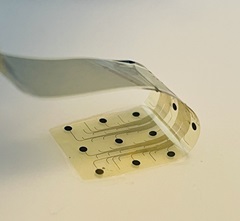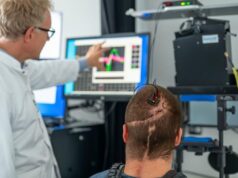
Inbrain Neuroelectronics has announced the “world’s first” human procedure involving its cortical brain-computer interface (BCI) in a patient undergoing brain tumour resection. According to a press release from the company, its BCI technology was able to differentiate between healthy and cancerous brain tissue with micrometre-scale precision.
This milestone represents a significant advancement in demonstrating the ability of graphene-based BCI technology—beyond decoding and translating brain signals—to potentially becoming a reliable tool for use in precision surgery in diseases like cancer, and in neurotechnology more broadly, Inbrain claims.
The clinical investigation study in question was sponsored by the University of Manchester (Manchester, UK), and primarily funded by the European Commission’s Graphene Flagship project. It was conducted at Salford Royal Hospital—part of the Northern Care Alliance NHS Foundation Trust in Manchester, UK—and led by chief clinical investigator David Coope, a neurosurgeon at the Manchester Centre for Clinical Neuroscience, and chief scientific investigator Kostas Kostarelos, a nanomedicine professor at the University of London (London, UK) and co-founder of Inbrain.
“The world’s first human application of a graphene-based BCI highlights the transformative impact of graphene-based neural technologies in medicine,” said Inbrain chief executive officer and co-founder Carolina Aguilar. “This clinical milestone opens a new era for BCI technology, paving the way for advancements in both neural decoding and its application as a therapeutic intervention.”
The recent release notes that Inbrain’s BCI platform leverages the “exceptional properties” of graphene—a material made of a single layer of carbon atoms. Despite being the thinnest material known to science, graphene is stronger than steel, and possesses a unique combination of electronic and mechanical properties that make it ideal for neurotechnology innovation, the release adds.
“We are capturing brain activity in areas where traditional metals and materials struggle with signal fidelity,” stated Coope, who performed the recently announced first procedure in the trial. “Graphene provides ultra-high density for sensing and stimulating, which is critical to conduct high-precision resections while preserving the patient’s functional capacities, such as movement, language or cognition.”
“After extensive engineering development and preclinical trials, Inbrain’s first-in-human study will involve 8–10 patients, primarily to demonstrate the safety of graphene in direct contact with the human brain,” Kostarelos added. “The study will also aim to demonstrate graphene’s superiority over other materials in decoding brain functionality in both awake and asleep states.”
“The integration of graphene and AI [artificial intelligence] with advanced semiconductor technology has allowed Inbrain to pioneer a new generation of minimally invasive BCI therapeutics designed for the personalised treatment of neurological disorders,” commented Jose Garrido, Inbrain’s co-founder and chief scientific officer.
Kostya Novoselov (National University of Singapore, Singapore), Nobel laureate and vision board member for Inbrain—who first isolated stable graphene at the University of Manchester in 2004—stated: “Witnessing graphene’s exceptional properties unlock new frontiers in medical technology is truly rewarding. This breakthrough—a result of a decade-long development under the Graphene Flagship programme—can now start to unravel its transformative societal impact.”
The present study is being powered by Inbrain’s graphene-based Intelligent Network Decoding and Modulation (BCI-Tx) platform, which has received Breakthrough Device designation for Parkinson’s disease from the US Food and Drug Administration (FDA). As detailed in the company’s recent release, the platform leverages graphene’s unique properties to deliver ultra-high signal resolution and adaptive neuroelectronic therapy, enabling real-time decoding of biomarkers and precise modulation of cortical and subcortical structures at the micrometre scale for neural network rebalancing.










